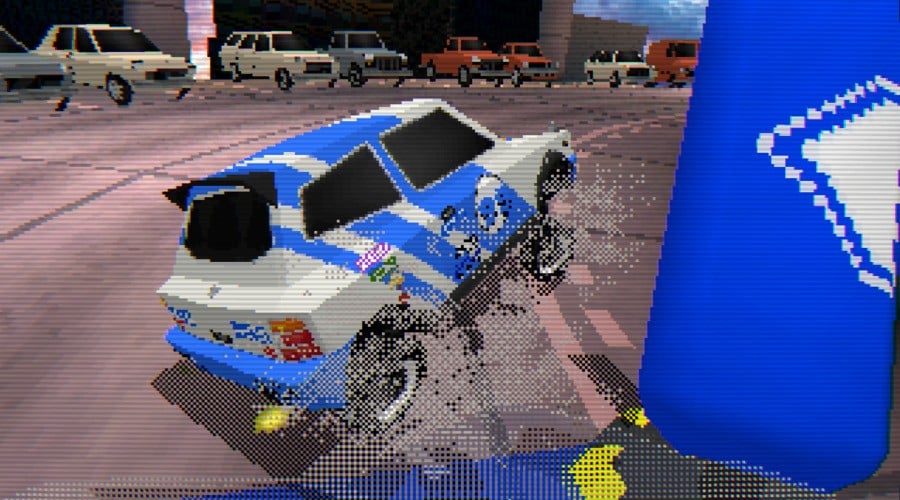
As we've mentioned before on the site, we pretty much fell in love immediately with the idea of Parking Garage Rally Circuit. So we've been champing at the bit ever since to find out everything we can about it.
Last month, we interviewed the developer Tim Fitzrandolph (also known as Walaber) to get some behind-the-scenes insight into the making of the game, and since then, we've also been granted the opportunity to try out an early Steam build. This build isn't exactly finished — there are still some tweaks to be made here and there before its release later this year on Steam — but it has provided us with a better look at what we can expect from the final product, and we're relieved to say it seems to be on course to live up to the high expectations we have set for it.
Parking Garage Rally Circuit, in case you haven't read any of our past coverage (or are in need of a quick refresher) is an upcoming racing game featuring Sega Saturn-like visuals and a ridiculous yet genius premise at its core. Essentially, you are a rally driver competing in a series of competitions, but instead of your run-of-the-mill dirt tracks and private roads, the courses are all comprised of compact parking garages forcing you to navigate around tight corners (and other cars) to get to the next available checkpoint.
In total, the game features 8 unique tracks, which include a basic learning garage, as well as several parking garages based around notable landmarks (Mt. Rushmore, San Francisco, Seattle Airport, New Orleans Stadium, Chicago Marina, Minnesota Mega Mall, and Liberty Island). These are visually distinct from one another and offer a decent amount of gameplay variety. The Chicago Marina map, for instance, is comprised of twin-looping parking columns that force players to make jumps from one parking column to the next while the snow-covered Minnesota Mega Mall has a series of large snow plows that the player will have to dodge on their way to finish line.
Currently, some of these are clearly more developed than others, with the Liberty Island map arguably being the weakest at the moment. Not only does it feature ghosts that currently take another slightly shorter route that's inaccessible to the player, but it also features a particularly challenging jump over the Statue of Liberty that serves as a pretty steep difficulty spike and took us a while before we were able to pull it off consistently. One of the biggest challenges with learning this jump was that it required us to build up enough speed, but the checkpoint placement was positioned in such a way as to make any re-attempts even more difficult than the initial task. According to Fitzrandolph, this stage is the most "work in progress", so hopefully, these issues will be a thing of the past when the final game releases, as this is definitely one of the more visually striking levels on offer.

In case you're wondering about the game's structure, it is divided into three different weight classes (light, heavy, and ultra-heavy), which act as an indicator of the difficulty (light being the easiest, ultra-heavy being the hardest). Players must select from one of these options before then choosing to compete across 8 different tracks in one of two modes: race or endurance. In the race mode, the initial goal for the player is to defeat three ghosts representing bronze, silver, and gold. But, once you manage to beat these, there's also an additional incentive to dive back in, as a ghost marking your best time and other nearby scores on the leaderboard will then be loaded in for you to compete against, challenging you to shave some additional seconds off your best time.
The endurance mode, meanwhile, provides players with a slightly different twist on the exact same maps, tasking you with completing as many laps as possible within a set time limit, with each subsequent checkpoint recovering valuable seconds to let you continue.
What interested us most, about getting some hands-on time with Parking Garage Rally Circuit, is that despite it potentially looking on the surface like it might be a successor to games like SEGA Rally or Daytona USA, the game interestingly plays a lot more closely to Mario Kart 8. It borrows Mario Kart's "starting speed boost" technique, for example, as well as taking advantage of a similar-styled drift system that sees players being able to perform additional turbo boosts to increase their top speed.
These boosts can be chained together in quick succession, and give the game a satisfying "arcade" feel that emphasizes fun over an exact simulation of rally driving. But they also occasionally make the car feel a bit too unpredictable, forcing you to time your drifts carefully to avoid smashing into nearby physics objects in the environment and prevent falling off the map.
In total, we've spent roughly 8 hours with the game so far, and we're looking forward to putting even more time into it in the coming weeks, to see if we can further improve our skills. Currently, there's no precise release date for the title, but Fitzrandolph has announced that if the game is successful, they will also be bringing it to Nintendo Switch and Sega Saturn.
